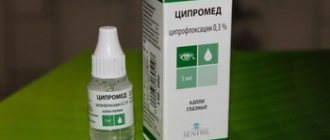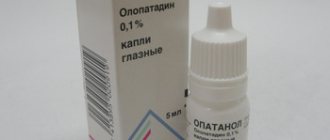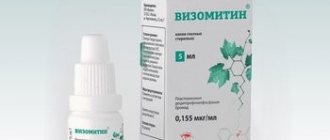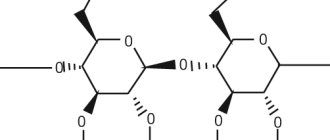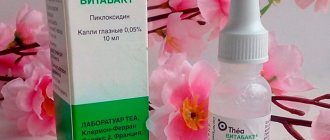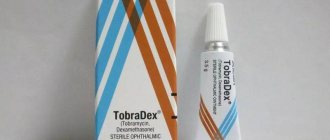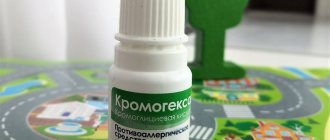Pharmacological properties of the drug Xalatan
Latanoprost (isopril-(Z)-7[(1R, 2R, 3R, 5S)3,5-dihydroxy-2-[(3R)-3-hydroxy-5-phenyl-1-pentyl]cyclopentyl]-5-heptenoate ) is an analogue of prostaglandin F2b, a selective agonist of the prostanoid FP receptor. Lowers intraocular pressure by increasing the outflow of aqueous humor from the eye; does not have a significant effect on the production of aqueous humor, does not affect the blood-ophthalmic barrier. The main mechanism of action is associated with an increase in uveoscleral outflow, and there is also a slight decrease in outflow resistance. The decrease in intraocular pressure begins approximately 3–4 hours after administration of the drug, the maximum effect is observed after 8–12 hours. Duration of action is at least 24 hours. Latanoprost in therapeutic doses has no effect on intraocular blood flow, as well as the cardiovascular and respiratory systems . When applied topically, conjunctival or episcleral hyperemia may develop (from slight to moderate). During a short course of treatment in pseudophakic patients, latanoprost did not cause fluorescein penetration into the posterior segment of the eye. Latanoprost (molecular weight 432.58 daltons) is an isopropyl ether and is a prodrug that, after hydrolysis to form latanoprost acid, becomes biologically active. It penetrates well through the cornea, and hydrolysis of the drug occurs to a biologically active form. The maximum concentration in the aqueous humor of the eye is reached approximately 2 hours after topical application of the drug. It is distributed primarily in the anterior segment, in the conjunctiva and eyelids, only a small amount of the drug reaches the posterior segment of the eye. It is practically not metabolized in the tissues of the eye; metabolism occurs mainly in the liver. In humans, the half-life of latanoprost is 17 minutes. The main metabolites (1,2-dinor and 1,2,3,4,-tetranor metabolites) have no or weak biological activity and are excreted mainly in the urine.
"XALATAN": composition
- The active substance involved in the process of restoration of the visual apparatus is latanoprost. The appearance of the chemical material is slightly yellowish, most often it does not have any tint. The structure of the substance is similar to an oily liquid. Reacts with many pharmaceutical components, but does not dissolve in aqueous solution. This remedy is very popular for pressure on the eyeball. It is sometimes used in cosmetology to naturally increase eyelashes, but this is dangerous and can lead to their improper development. The drug contains 50 mcg or 0.05 mg of the ingredient;
- One of the most important excipients is chloride. It is known for its great functionality, because the component is used for damage to the mucous membrane by bacteria, dehydration, and in the fight against microbes. Chloride is a good antiseptic and quickly relieves wounds from festering. Found in the form of a colorless liquid. The amount of chemical material in the medicine is 4.1 mg;
- Monohydrate, or rather sodium dihydrogen phosphate, are crystals that have no color. They dissolve perfectly in water. The substance is used by doctors to restore a person’s mineral balance to normal. The mass of the ingredient in the medicine is 4.6 mg;
- The remaining excipients are anhydrous sodium hydrogen phosphate (4.74 mg), benzalkonium chloride (0.2 mg), water (995 mg).
Use of the drug Xalatan
Adults (including elderly people) are prescribed 1 drop into the affected eye once a day. The optimal effect is achieved if Xalatan is instilled in the evening. The frequency of use of Xalatan should not exceed 1 time per day, since it has been established that with more frequent instillation, the effectiveness of the drug in terms of its effect on intraocular pressure decreases. If a dose is missed, the next one should be administered as usual (1 drop of the drug). Xalatan can be used for both mono- and combination therapy. When prescribing combination therapy, other eye drops should be instilled at intervals of at least 5 minutes. The safety and effectiveness of the drug in children has not been established.
Analogues of Xalatan
Level 4 ATC code matches: Glauprost
Travatan
Analogues include the following drugs: Arutimol , Glaumol , Iotim , Kusimolol , Niolol , Normatin , Okumed , Okuril , Oftan Timolol , Timolol .
Side effects of the drug Xalatan
Approximately 10% of patients who are constantly receiving treatment with the drug experience slight hyperemia of the conjunctiva, and approximately 1% have moderate hyperemia. Some patients experience pinpoint epithelial erosions (in most cases they are asymptomatic), increased pigmentation of the iris, and in isolated cases macular edema (mainly in patients with aphakia or pseudophakia, with the lens in the anterior chamber of the eye). In isolated cases, skin rashes of unknown etiology were observed during treatment.
How does it affect the body?
The key substance is involved in all further activities of the visual apparatus. The most important advantage of the chemical material is its ability to withstand the pressure that occurs inside the eye. This can happen due to various unfavorable factors, non-compliance with the rules of maintaining vision while sitting at the monitor, overexertion, stress. Latanoprost reduces aqueous fluid in the visual apparatus. This occurs by removing fluid through special structural formations, a process called uveoscleral. The trabecular meshwork, a natural component that removes excess watery substance from the eye, is used to achieve the greatest effect. A person will feel the first results from taking it after 4 hours. Then there will be a gradual improvement in the body's condition. The effectiveness becomes noticeable after 12 hours from the time of use of the pharmaceutical product.
Special instructions for the use of Xalatan
Xalatan may cause a gradual change in eye color by increasing the amount of brown pigment in the iris. This effect occurs predominantly in patients with mixed iris colors, such as blue-brown, gray-brown, green-brown, or yellow-brown, which is explained by an increase in melanin content in the melanocytes of the iris. Typically, brown pigmentation extends concentrically around the pupil to the periphery of the iris, and all or parts of it may become a more intense brown color. The results of the clinical trial show that in patients with uniformly colored eyes of blue, grey, green or brown, changes in eye color were observed very rarely after 2 years of treatment. Changes in iris color develop slowly and may not be noticeable for months or even years. Clinical trials have confirmed that the color change is not accompanied by any clinical symptoms or pathological changes. After discontinuation of the drug, no further increase in the amount of brown pigment was observed, however, the color change that has already developed may be irreversible. Until the results of long-term studies are available, it is recommended that patients with mixed iris coloration be prescribed this drug only if other drugs that reduce intraocular pressure are not effective enough or are poorly tolerated. In the presence of nevi or lentigines on the iris, no changes were noted under the influence of latanoprost therapy. Clinical trials did not reveal pigment accumulation in the trabecular meshwork or in any other part of the anterior chamber of the eye. Before starting treatment, patients should be informed about the possibility of changes in eye color. Treatment of only one eye can lead to permanent heterochromia. Currently, there is no data on the use of Xalatan in inflammatory eye diseases, inflammatory, neovascular, angle-closure and congenital glaucoma; There is little experience with the use of Xalatan in open-angle glaucoma in patients with pseudophakia, as well as in pigmentary glaucoma. Xalatan has no or negligible effect on the pupil, but no data have been obtained on the effect of the drug during an acute attack of angle-closure glaucoma. Therefore, until sufficient clinical experience has been accumulated, Xalatan is recommended to be used with caution in these conditions. Xalatan contains benzalkonium chloride, which can be absorbed by contact lenses. Contact lenses should be removed before instilling Xalatan; You can put on lenses only 15 minutes after instillation. The drug can be used during pregnancy only if the potential benefit clearly outweighs the potential risk to the fetus. Latanoprost and its metabolites can pass into breast milk, so Xalatan should be administered with caution to breastfeeding women. When using Xalatan (as well as other ophthalmic drugs), a short-term sensation of a veil before the eyes may develop, which must be taken into account when driving vehicles and working with potentially dangerous mechanisms.
Side effects of Xalatan
Xalatan, according to reviews, can cause visual impairment. Among them, eye irritation is most often observed in the form of a feeling of sand in the eyes, burning sensation, itching, tingling and foreign body sensation. The effect of Xalatan on the eyelashes can lead to a deepening of the upper eyelid furrow. In addition, visual impairment most often manifests itself in the form of:
- Blepharitis;
- Conjunctival hyperemia;
- Pain in the eyes;
- Increased pigmentation of the iris;
- Iritis or uveitis;
- Transient point erosions of the corneal epithelium;
- Swelling of the eyelids;
- Dryness of the mucous membrane of the eyes;
- Keratitis;
- Edema and erosion of the cornea, periorbital edema;
- Conjunctivitis;
- Blurred vision;
- Photophobia;
- Macular edema, including cystoid.
The effect of Xalatan on eyelashes can lead to:
- Changes in the direction of eyelash growth, which in some cases causes eye irritation;
- Changes in the form of thickening, lengthening, increasing the number and increasing pigmentation of both eyelashes and vellus hair;
- The appearance of an additional row of eyelashes above the meibomian glands.
This effect of Xalatan on eyelashes is usually temporary.
Also, Xalatan, according to reviews, can lead to the development of:
- Rash, darkening of the skin of the eyelids and local skin reactions on the eyelids, toxic epidermal necrolysis (skin);
- Dyspnea and bronchospasm, including acute attacks or exacerbation of the disease if there is a history of it (respiratory system);
- Dizziness and headache (nervous system);
- Pain in joints and muscles (musculoskeletal system).
In addition, according to reviews, Xalatan can cause nonspecific chest pain, retinal artery embolism and detachment, and herpetic keratitis.
Xalatan drops in children cause the same side effects as in adults. Also, in some cases, when using the medication in children, fever and nasopharyngitis were observed.
Benzalkonium chloride, which is part of Xalatan, can be absorbed by contact lenses, so it is recommended to remove them before the procedure and put them on after 15 minutes.
During therapy, a gradual increase in brown pigment in the iris may be observed, which is caused by an increase in the content of melanin in the stromal melanocytes of the iris. Typically, this occurs when the iris color is mixed with a brown base color.
Typically, such an increase in iris pigmentation occurs most intensely during the first year of therapy. The rate of pigmentation progression gradually stabilizes and decreases over 5 years of use of the medication.
Drug interactions Xalatan
Latanoprost has an additive effect in lowering intraocular pressure when used in combination with β-adrenergic receptor blockers (timolol), adrenomimetics (epinephrine, dipivalil), carbonic anhydrase inhibitors (acetazolamide) and a partial additive effect when used in combination with cholinomimetics (pilocarpine). In vitro studies have shown that when eye drops containing thiomersal are mixed with Xalatan, precipitation occurs. Therefore, eye drops containing these substances should be used at intervals of at least 5 minutes.
Xalatan drug interactions
When Xalatan is used simultaneously with medications with similar effects, a paradoxical increase in intraocular pressure is observed, therefore such combinations of drugs are not recommended.
Also, Xalatan should not be used with ophthalmic products containing thiomersal, as this may cause precipitation.
When prescribing several ophthalmic medications, it is recommended to maintain an interval of at least five minutes between their use.
Xalatan drug overdose, symptoms and treatment
In case of an overdose of Xalatan, eye irritation and conjunctival hyperemia were observed; No other ocular side effects were noted. If you accidentally take Xalatan orally, you should keep in mind that 1 bottle contains 125 mcg of latanoprost. Over 90% is metabolized during the initial passage through the liver. IV infusion of latanoprost at a dose of 3 mcg/kg to healthy volunteers did not cause the development of any symptoms, however, when administered at a dose of 5–10 mcg/kg, nausea, abdominal pain, dizziness, headache, general weakness, and flushing occurred. to the face and increased sweating. When latanoprost was used in doses 7 times higher than therapeutic doses, no effect on pulmonary function, heart rate or blood pressure was observed in patients with asthma. If necessary, carry out symptomatic treatment.
Contraindications
- Age up to 1 year (the effectiveness and safety of latanoprost for this age group of patients has not been established);
- Hypersensitivity to the components of the drug.
Pregnant women can use the drug only after assessing the balance between the benefits of the therapy and possible harm to the fetus (due to the lack of adequate controlled studies).
Xalatan should be used with caution in the presence of the following diseases/conditions:
- Aphakia, pseudophakia with rupture of the posterior capsule of the lens;
- Risk factors for the development of macular edema (cases of macular edema, including cystoid, have been described when using latanoprost);
- Risk factors for the development of uveitis/iritis;
- Inflammatory, neovascular glaucoma (due to insufficient data on the safety and effectiveness of the drug in these diseases);
- Bronchial asthma, history of herpetic keratitis;
- Lactation period.
The use of Xalatan is not recommended in patients with herpetic keratitis (recurrent or active), especially associated with the use of prostaglandin F2α analogues.
When planning surgery for cataracts, the drug should be used with caution.
Changing eye color during glaucoma treatment
Long-term therapy with Xalatan leads to changes in iris color as melanin production increases. Pigmentation of the iris is not accompanied by pathological changes in the structures of the eye, but is irreversible.
This side effect does not usually occur in people who have uniform gray, green, brown, or blue irises. Patients whose eyes have an uneven brown-blue, brown-gray, brown-green, or brown-yellow tint are more susceptible to pigmentation. The color change begins from the center, over the years covering the periphery of the iris. When Xalatan is discontinued, pigmentation stops, but the acquired brown color remains. Pigmentation of other parts of the eye does not occur during the use of Xalatan.
In addition to pigmentation of the iris, darkening of the eyelids, changes in eyelashes and vellus hair are also possible. In some patients, the direction of eyelash growth changes, which persists even after stopping Xalatan. Since long-term studies of these effects have not been conducted, it is recommended to prescribe Xalatan only in cases where medications to lower blood pressure have been ineffective.
The effectiveness of Xalatan eye drops
The maximum concentration of latanoprost is achieved 2 hours after administration of Xalatan. Active acid is determined in the eye fluid only in the first 4 hours, and in the blood plasma - in the first hour.
A decrease in pressure is observed 3-4 hours after instillation of Xalatan, and the maximum effect is observed after 10 hours. Even after a single instillation, the effect of the drug lasts more than a day. During primary treatment, 90% of latanoprost is metabolized by the liver.
According to studies, latanoprost reduces intraocular pressure by 6-8 mm. Hg Art. in patients with an initial pressure of 24-25 mm. Hg Art. after 6 months of use. The effectiveness of the drug in treating young and elderly patients does not differ significantly.
Xalatan is more effective than drugs containing thymol, but latanoprost can cause benign pigmentation of the iris. Latanoprost is also more effective in patients with angle-closure glaucoma who have not responded to surgery (iridotomy or iridectomy).
"XALATAN" (eye drops): instructions for use
Remember, the use of the medicine must be competent, subject to the dosages and timing prescribed in the instructions for use. Otherwise, you risk the health of your eyes and the well-being of your body as a whole.
How to use?
- The drug is available in drop format. This is the most optimal type of drug for ophthalmic purposes, giving immediate results;
- Algorithm of action: bring the bottle perpendicular to the eye, drop one drop of the medicine, then press on the lacrimal punctum located below, at the inner corner of the visual apparatus. It is located on the lower eyelid;
- The use of drops should be strictly one-time in 24 hours, used only on the damaged eye, there is no need to do this fraud with a healthy eye;
- If you miss a day of administration, you do not need to double the dose. The main reason for the ban is considered to be addiction; the medication will no longer have a proper effect on the body;
- When prescribing additional eye drops, it is not recommended to use all medications at the same time. We advise you to wait a few minutes.
"XALATAN": price
The pharmaceutical product is very popular in Russia, so it won’t be difficult to find it on store shelves. But, it will be useful for the thrifty buyer to find out where it will be more profitable to purchase this product and not fall for the placebo:
- Uteka offers its visitors to buy drops for 600 rubles;
- In ASNA the starting price is 305 rubles;
- The “White Medicines” pharmacy costs 650 rubles;
- You can buy it at MedTorg for 666 rubles;
- For clients of “Pharmacy 313” the price category of the product will be 700 rubles.
"XALATAN": reviews
To ensure the quality of the medicine, let’s read the positive comments left by satisfied patients about the effectiveness of the drops:
I never paid attention to my problem. But one day, my headache was so bad that no pills helped. I turned to a therapist, he referred me to an ophthalmologist and everything was revealed there. He prescribed medication, after the first dose, I felt improvement;
I had perfect vision, so when it started to drop sharply, I became worried. I contacted an ophthalmologist. He made a disappointing diagnosis - glaucoma. I was in despair, I dripped the product, but at first I did not notice the result. Only after another visit to the doctor, I realized that the condition of my eyes was improving!
I always knew that everything was terrible with my eyes. This was evidenced by the pressure; it did not allow me to work normally or do everyday things. But, thanks to Xalatan, I managed to improve the situation, not much, but now I see better than half a year ago;
Wearing glasses, I didn’t notice my problem for a long time. Pain in the eyes and their heaviness were commonplace for me, but then I began to understand that something was abnormal with me. I went to the doctor, he sent me for testing, which revealed glaucoma. I was treated with drops, they helped a lot with my illness!
